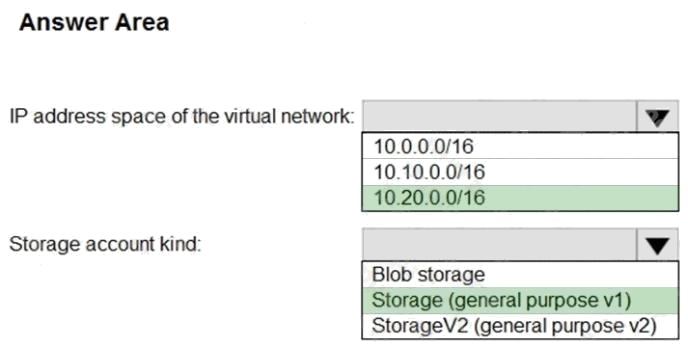microsoft AZ-303 Exam Questions
Questions for the AZ-303 were updated on : Jun 27 ,2025
Page 1 out of 30. Viewing questions 1-15 out of 449
Question 1 Topic 1, Case Study 1Case Study Question View Case
HOTSPOT
You need to identify the storage requirements for Contoso.
For each of the following statements, select Yes if the statement is true. Otherwise, select No.
NOTE: Each correct selection is worth one point.
Hot Area:
Answer:

Explanation:
Box 1: Yes
Scenario: Move the existing product blueprint files to Azure Blob storage.
Scenario: Use unmanaged standard storage for the hard disks of the virtual machines.
Page blobs are optimized for writes at random locations within a blob. They also support Unmanaged Disks.
Scenario:
SQL Server Data Files in Microsoft Azure enables native support for SQL Server database files stored as blobs. It allows you
to create a database in SQL Server running in on-premises or in a virtual machine in Microsoft Azure with a dedicated
storage location for your data in Microsoft Azure Blob storage.
Box 2: No
Box 3: No
Reference:
https://docs.microsoft.com/en-us/sql/relational-databases/databases/sql-server-data-files-in-microsoft-azure
Implement Management and Security Solutions
Question 2 Topic 1, Case Study 1Case Study Question View Case
You need to move the blueprint files to Azure.
What should you do?
- A. Use the Azure Import/Export service.
- B. Generate a shared access signature (SAS). Map a drive, and then copy the files by using File Explorer.
- C. Use Azure Storage Explorer to copy the files.
- D. Generate an access key. Map a drive, and then copy the files by using File Explorer.
Answer:
D
Explanation:
Scenario: Copy the blueprint files to Azure over the Internet.
To mount an Azure file share, you will need the primary (or secondary) storage key. SAS keys are not currently supported for
mounting.
Incorrect Answers:
A: Azure Import/Export service is used to securely import large amounts of data to Azure Blob storage and Azure Files by
shipping disk drives to an Azure datacenter.
Reference: https://docs.microsoft.com/en-us/azure/storage/files/storage-how-to-use-files-windows
Question 3 Topic 1, Case Study 1Case Study Question View Case
You need to implement a backup solution for App1 after the application is moved.
What should you create first?
- A. an Azure Backup Server
- B. a Recovery Services vault
- C. a recovery plan
- D. a backup policy
Answer:
B
Explanation:
Scenario: Ensure that all the virtual machines for App1 are protected by backups.
You can back up Azure VMs using a couple of methods:
Single Azure VM: You can back up an Azure VM directly from the VM settings.
Multiple Azure VMs: You can set up a Recovery Services vault and configure backup for multiple Azure VMs.
Reference: https://docs.microsoft.com/en-us/azure/backup/backup-azure-vms-first-look-arm
Implement Management and Security Solutions
Question 4 Topic 2, Case Study 2Case Study Question View Case
HOTSPOT
You are evaluating the connectivity between the virtual machines after the planned implementation of the Azure networking
infrastructure.
For each of the following statements, select Yes if the statement is true. Otherwise, select No.
Hot Area: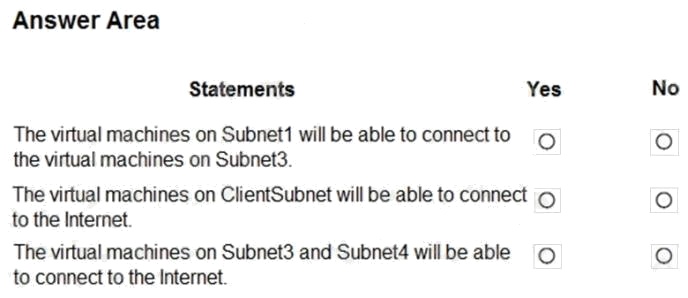
Answer:
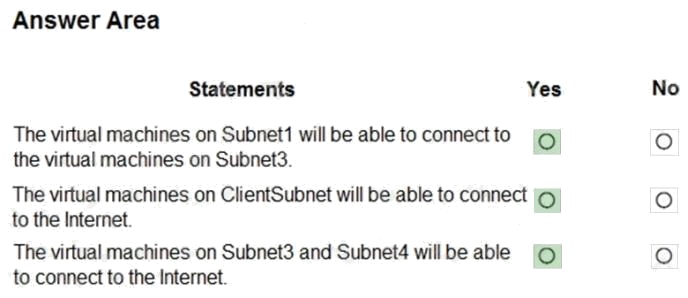
Explanation:
Once the VNets are peered, all resources on one VNet can communicate with resources on the other peered VNets. You
plan to enable peering between Paris-VNet and AllOffices-VNet. Therefore VMs on Subnet1, which is on Paris-VNet and
VMs on Subnet3, which is on AllOffices-VNet will be able to connect to each other.
All Azure resources connected to a VNet have outbound connectivity to the Internet by default. Therefore VMs on
ClientSubnet, which is on ClientResources-VNet will have access to the Internet; and VMs on Subnet3 and Subnet4, which
are on AllOffices-VNet will have access to the Internet.
References: https://docs.microsoft.com/en-us/azure/virtual-network/virtual-network-peering-overview
https://docs.microsoft.com/en-us/azure/networking/networking-overview#internet-connectivity
Question 5 Topic 2, Case Study 2Case Study Question View Case
DRAG DROP
You need to prepare the environment to ensure that the web administrators can deploy the web apps as quickly as possible.
Which three actions should you perform in sequence? To answer, move the appropriate actions from the list of actions to the
answer area and arrange them in the correct order.
Select and Place: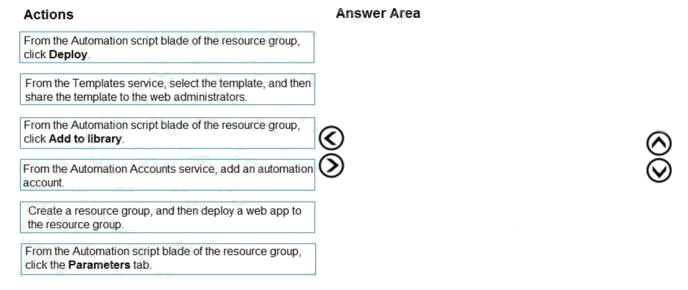
Answer:
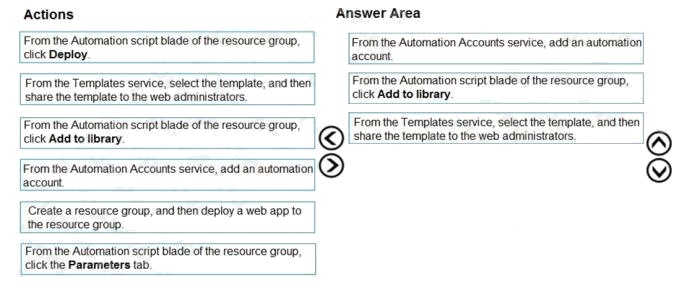
Explanation:
Step 1:
First you create a storage account using the Azure portal.
Step 2:
Select Automation options at the bottom of the screen. The portal shows the template on the Template tab.
Add the storage account to the library.
Step 3:
Share the template.
Scenario: Web administrators will deploy Azure web apps for the marketing department. Each web app will be added to a
separate resource group. The initial configuration of the web apps will be identical. The web administrators have permission
to deploy web apps to resource groups.
References: https://docs.microsoft.com/en-us/azure/azure-resource-manager/resource-manager-quickstart-create-
templates-use-the-portal
Question 6 Topic 2, Case Study 2Case Study Question View Case
You need to resolve the licensing issue before you attempt to assign the license again.
What should you do?
- A. From the Directory role blade, modify the directory role
- B. From the Groups blade, invite the user accounts to a new group
- C. From the Profile blade, modify the usage location
Answer:
C
Explanation:
License cannot be assigned to a user without a usage location specified.
Scenario: Licensing Issue
You attempt to assign a license in Azure to several users and receive the following error message: "Licenses not assigned.
License agreement failed for one user." You verify that the Azure subscription has the available licenses.
Question 7 Topic 2, Case Study 2Case Study Question View Case
You need to define a custom domain name for Azure AD to support the planned infrastructure.
Which domain name should you use?
- A. ad.humongousinsurance.com
- B. humongousinsurance.local
- C. humongousinsurance.com
- D. humongousinsurance.onmicrosoft.com
Answer:
C
Explanation:
Every Azure AD directory comes with an initial domain name in the form of domainname.onmicrosoft.com. The initial domain
name cannot be changed or deleted, but you can add your corporate domain name to Azure AD as well. For example, your
organization probably has other domain names used to do business and users who sign in using your corporate domain
name. Adding custom domain names to Azure AD allows you to assign user names in the directory that are familiar to your
users, such as [email protected]. instead of 'alice@domain name.onmicrosoft.com'.
Scenario:
Network Infrastructure: Each office has a local data center that contains all the servers for that office. Each office has a
dedicated connection to the Internet.
Humongous Insurance has a single-domain Active Directory forest named humongousinsurance.com Planned Azure AD
Infrastructure: The on-premises Active Directory domain will be synchronized to Azure AD.
References: https://docs.microsoft.com/en-us/azure/active-directory/fundamentals/add-custom-domain
Question 8 Topic 3, Case Study 3Case Study Question View Case
You need to implement a backup solution for App1 after the application is moved.
What should you create first?
- A. an Azure Backup Server
- B. a Recovery Services vault
- C. a backup policy
- D. a recovery plan
Answer:
B
Explanation:
Scenario: Ensure that all the virtual machines for App1 are protected by backups.
You can back up Azure VMs using a couple of methods:
Single Azure VM: You can back up an Azure VM directly from the VM settings.
Multiple Azure VMs: You can set up a Recovery Services vault and configure backup for multiple Azure VMs.
References: https://docs.microsoft.com/en-us/azure/backup/backup-azure-vms-first-look-arm
Question 9 Topic 3, Case Study 3Case Study Question View Case
HOTSPOT
You need to identify the storage requirements for Contoso.
For each of the following statements, select Yes if the statement is true. Otherwise, select No.
NOTE: Each correct selection is worth one point.
Hot Area: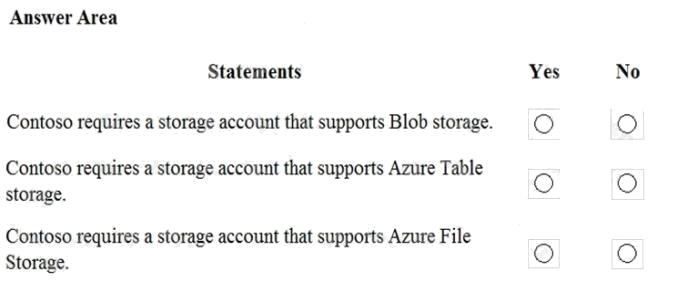
Answer:
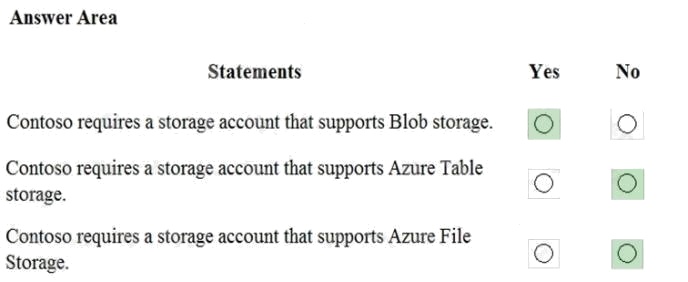
Explanation:
Box 1: Yes
Scenario: Move the existing product blueprint files to Azure Blob storage.
Scenario: Use unmanaged standard storage for the hard disks of the virtual machines.
Page blobs are optimized for writes at random locations within a blob. They also support Unmanaged Disks.
Scenario:
SQL Server Data Files in Microsoft Azure enables native support for SQL Server database files stored as blobs. It allows you
to create a database in SQL Server running in on-premises or in a virtual machine in Microsoft Azure with a dedicated
storage location for your data in Microsoft Azure Blob storage.
Box 2: No
Box 3: No
References:
https://docs.microsoft.com/en-us/sql/relational-databases/databases/sql-server-data-files-in-microsoft-azure
Question 10 Topic 3, Case Study 3Case Study Question View Case
You need to move the blueprint files to Azure.
What should you do?
- A. Use the Azure Import/Export service.
- B. Use Azure Storage Explorer to copy the files.
- C. Generate a shared access signature (SAS). Map a drive, and then copy the files by using File Explorer.
- D. Generate an access key. Map a drive, and then copy the files by using File Explorer.
Answer:
D
Explanation:
Scenario: Copy the blueprint files to Azure over the Internet.
To mount an Azure file share, you will need the primary (or secondary) storage key. SAS keys are not currently supported for
mounting.
Incorrect Answers:
A: Azure Import/Export service is used to securely import large amounts of data to Azure Blob storage and Azure Files by
shipping disk drives to an Azure datacenter.
References: https://docs.microsoft.com/en-us/azure/storage/files/storage-how-to-use-files-windows
Question 11 Topic 3, Case Study 3Case Study Question View Case
HOTSPOT
You need to recommend a solution for App1. The solution must meet the technical requirements.
What should you include in the recommendation? To answer, select the appropriate options in the answer area.
NOTE: Each correct selection is worth one point.
Hot Area: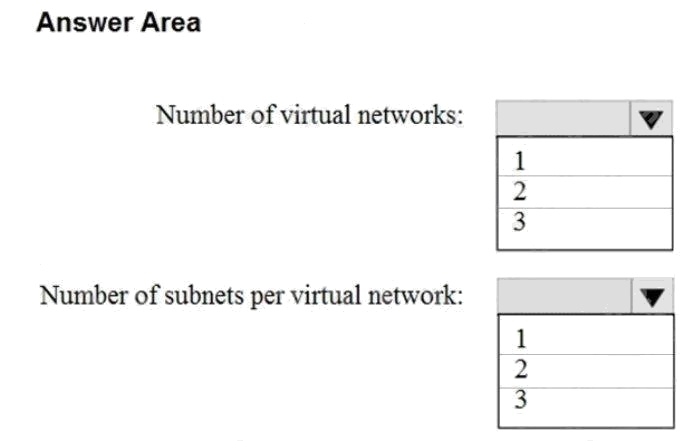
Answer:
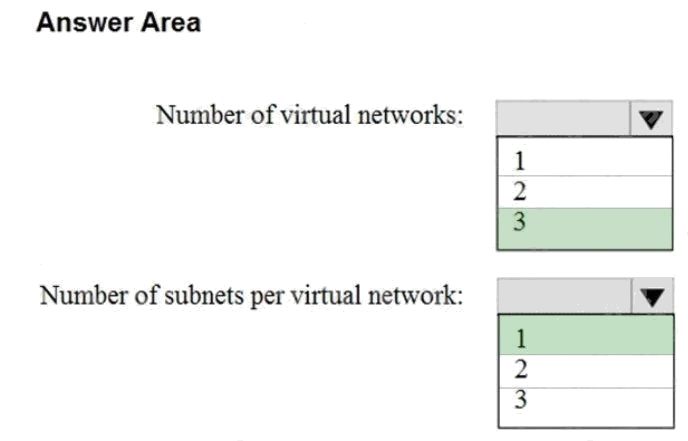
Explanation:
Box 1: 3
One virtual network for every tier
Box 2: 1
Only one subnet for each tier, to minimize the number of open ports.
Scenario: You have a public-facing application named App1. App1 is comprised of the following three tiers:
A SQL database
A web front end
A processing middle tier
Each tier is comprised of five virtual machines. Users access the web front end by using HTTPS only.
Technical requirements:
Move all the virtual machines for App1 to Azure.
Minimize the number of open ports between the App1 tiers.
Legacy AZ-300: Implement Workloads and Security
Question 12 Topic 4, Case Study 4Case Study Question View Case
You need to configure AG1.
What should you create?
- A. a multi-site listener
- B. a basic routing rule
- C. a URL path-based routing rule
- D. a basic listener
Answer:
C
Explanation:
References: https://docs.microsoft.com/en-us/azure/application-gateway/application-gateway-create-url-route-portal
Question 13 Topic 4, Case Study 4Case Study Question View Case
DRAG DROP
You need to configure the Azure ExpressRoute circuits.
How should you configure Azure ExpressRoute routing? To answer, drag the appropriate configurations to the correct
locations. Each configuration may be used once, more than once, or not at all. You may need to drag the split bar between
panes or scroll to view content.
NOTE: Each correct selection is worth one point.
Select and Place:
Answer:
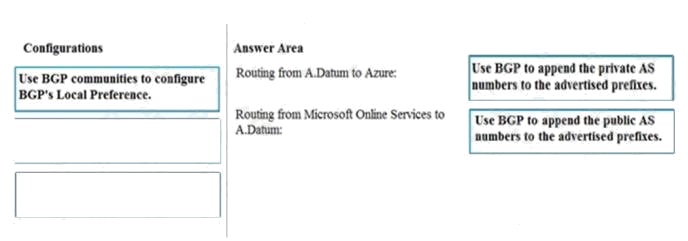
Explanation:
Azure compute services, namely virtual machines (IaaS) and cloud services (PaaS), that are deployed within a virtual
network can be connected through the private peering domain. The private peering domain is considered to be a trusted
extension of your core network into Microsoft Azure.
Services such as Azure Storage, SQL databases, and Websites are offered on public IP addresses. You can privately
connect to services hosted on public IP addresses, including VIPs of your cloud services, through the public peering routing
domain. You can connect the public peering domain to your DMZ and connect to all Azure services on their public IP
addresses from your WAN without having to connect through the internet.
References: https://docs.microsoft.com/en-us/azure/expressroute/expressroute-circuit-peerings
Question 14 Topic 4, Case Study 4Case Study Question View Case
DRAG DROP
You need to prepare the New York office infrastructure for the migration of the on-premises virtual machines to Azure.
Which four actions should you perform in sequence? To answer, move the appropriate actions from the list of actions to the
answer area and arrange them in the correct order.
Select and Place: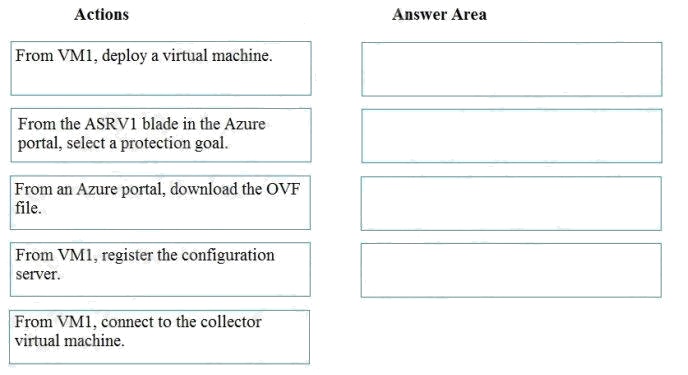
Answer:
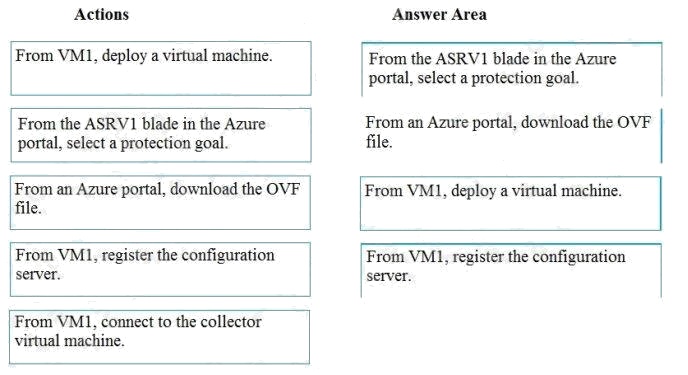
Explanation:
References: https://docs.microsoft.com/en-us/azure/site-recovery/vmware-azure-tutorial
Question 15 Topic 4, Case Study 4Case Study Question View Case
HOTSPOT
You need to provision the resources in Azure to support the virtual machine that will be migrated from the New York office.
What should you include in the solution? To answer, select the appropriate options in the answer area.
NOTE: Each correct selection is worth one point.
Hot Area: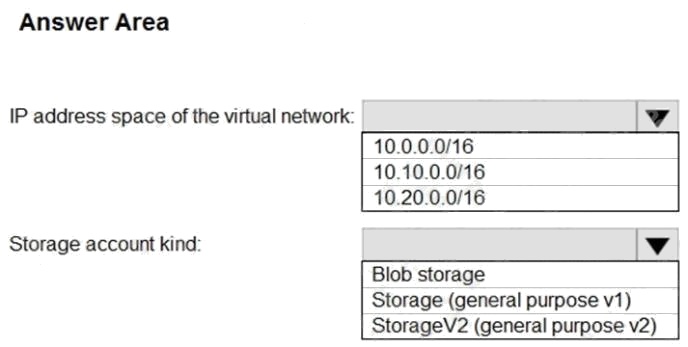
Answer:
